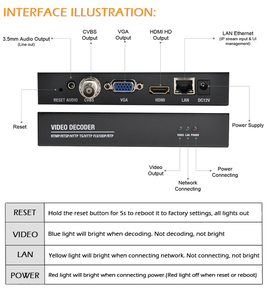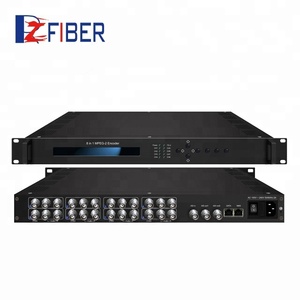Types CVBS IP encoders
A CVBS IP encoder is a video encoder that converts Composite Video Baseband Signal (CVBS), which is a simple RCA jack video output, into an Internet Protocol (IP) stream. Here are some types of CVBS IP encoders based on channels and functionality:
-
1. Single Channel CVBS IP Encoder:
A single-channel CVBS encoder can convert the analog video signal from one CVBS source into a digital format and stream it over an IP network. This process involves taking the composite video signal, which typically includes all video information in a single RCA connector, and encoding it to be viewable online. Single-channel encoders are most useful for applications where only one camera feed or CVBS source needs to be broadcast digitally, such as directly streaming a single surveillance camera feed to the web.
-
2. Multi-channel CVBS IP Encoder:
Unlike the single-channel encoder that handles just one source at a time, multi-channel encoders can take multiple CVBS inputs simultaneously and convert them for IP streaming. Multi-channel encoders usually have several composite video input ports so that multiple cameras or analog video sources can be connected directly. These encoders allow monitoring and distributing multiple analog video signals over an IP network from a single device.
-
3. CVBS to RTMP Encoder:
Real-Time Messaging Protocol (RTMP) is a protocol for streaming of audio, video and data over the Internet. RTMP is used for streaming to Flash Player, so broadcasting to Flash Player can be done from a CVBS source using a CVBS to RTMP encoder that would convert the CVBS signal into a format that can be streamed to Flash Player via RTMP.
-
4. CVBS to HLS Encoder:
HTTP Live Streaming (HLS) is an adaptive bitrate streaming protocol. A CVBS to HLS encoder would convert the CVBS signal into HLS format for streaming over HTTP. This allows delivering multiple bitrate streams for adaptive playback from a CVBS source.
Functions and Features of CVBS IP Encoder
The core function of a CVBS encoder is to convert analog video from a composite video source into a digital format that can be transmitted over an IP network. This allows users to stream or record the video content in digital form. Here are some of the features of CVBS IP encoders;
- Video compression: To optimize bandwidth usage and storage requirements, CVBS encoders typically employ video compression techniques. Common compression formats include H.264 or H.265, which effectively reduce the file size while maintaining acceptable video quality.
- Network connectivity: CVBS encoders have built-in network interfaces (Ethernet port) to connect to the IP network for video transmission. They may support various network protocols, such as TCP/IP, UDP/RTP, HTTP, RTSP, and RTMP, to ensure compatibility with different streaming systems and protocols.
- Audio encoding: Many CVBS encoders also incorporate audio encoding capabilities to include an audio component in the digital video stream. They can capture and encode the accompanying audio signal from the composite video source, allowing synchronized audio and video in the IP stream. Similarly, audio encoding employs compression techniques like AAC or MP3 to compress the audio portion of the signal.
- Streaming protocols: Variable Bit Rate (VBR) encoders adjust the bit rate dynamically based on the complexity of the video content. In contrast, Constant Bit Rate (CBR) encoders maintain a fixed bit rate throughout the stream. Choosing between VBR and CBR depends on factors such as desired video quality, bandwidth constraints, and the variability of the source material's complexity.
- Customization settings: CVBS encoders offer settings to customize encoding parameters like resolution, frame rate, bit rate, and compression format. This allows users to optimize the encoded stream based on their specific requirements and network conditions.
- Multiple streams: Some CVBS encoders support the capability to generate multiple simultaneous streams from a single source. This function enables users to create different encoded versions optimized for various devices or applications simultaneously, improving flexibility in content distribution.
- Remote management: Many Composite Video Baseband Signal (CVBS) encoders come with a web-based interface or management system that allows for easy configuration and management of the device settings. Additionally, encoders may support features like SNMP (Simple Network Management Protocol) for remote monitoring and management, which enables proactive maintenance and troubleshooting of the device from a remote location.
Uses of CVBS IP encoder
Applications for a CVBS encoder include sites that need to broadcast video over the internet or intranet. This includes institutions like schools and colleges, recording and security systems, media and broadcasting company, and live event venues. Other areas where the encoder is commonly used include digital signage, telemedicine, video conferencing, hospitality, and transportation.
- Security and surveillance: IP CVBS encoders transform analog CCTV camera footage into digital streams that may be stored and watched online. This guarantees that crucial surveillance footage is never lost and enhances the accessibility and management of video security systems.
- Broadcasting and media production: For live streaming events, sports, or content production, CVBS encoders are essential. They capture analog video sources—like cameras or production gear—and convert them into a digital format for live streaming or archiving.
- Video conferencing: Conference rooms that use traditional analog video sources (like a presentation from a video conference) may use a CVBS encoder to integrate them into a digital video conferencing system, allowing remote participants to view the presentation.
- Education: Universities and schools may use CVBS encoders to broadcast lectures, recordings, or presentations over the web or an internal network to digital content storage or e-learning platforms, improving access to educational materials for students and faculty.
- Healthcare: To transmit analog video signals from medical devices (such as endoscopes or ultrasound machines) into a digital format for telemedicine, remote consultations, or digital records, CVBS encoders are employed in the medical field.
- Transportation: Traffic cameras and other monitoring tools in public transit systems use CVBS encoders to transform analog video feeds into digital formats for analysis, monitoring, and managing purposes.
- Hospitality: In hotels and restaurants, CVBS encoders may be utilized to create digital signage solutions by converting analog video sources into a network for displaying promotions, information, or entertainment on a screens array.
How to Choose CVBS IP Encoder
Many factors are to be considered when selecting a CVBS to IP encoder that will suit the application. Here are the ones that should be examined keenly.
- The Number of Input Channels: The encoder's practicality and efficiency highly depend on the number of input channels it possesses. A single-channel encoder can convert one CVBS input to IP output. In contrast, a multi-channel encoder can transform several CVBS inputs into an IP output which makes it ideal for bulk encoding tasks.
- Encoder's Resolution and Bitrate: The quality and clarity of video content are influenced by the resolution, and parameters like file size and network bandwidth are impacted by bitrate. To satisfy specific application needs, it is crucial to strike a balance between these factors.
- Encoding Formats: The encoding format, also known as the container format, determines how the digital video is packaged and processed. Choosing an encoder that supports the desired format for playback and storage is necessary for compatibility with network infrastructure, storage systems, and end-user devices.
- Real-Time Streaming: Some applications, like video surveillance systems, require immediate streaming, while others may prioritize background processing. It is essential to evaluate the application's functionality requirements and select an encoder that meets the necessary latency standards.
- Network Protocols: The IP encoder should seamlessly interface with existing network infrastructure.
- Scalability: Future expansion should be accommodated by the encoder solution.
- Reliability and Stability: Especially for critical systems like surveillance, the encoder must consistently produce accurate and timely results.
- Cost Consideration: When choosing a CVBS to IP encoder, budget constraints and return on investment must be compared against the features it offers.
CVBS IP encoder Q & A
Q1 What is the function of a CVBS IP encoder?
A1 The motor vehicle video encoder converts CVBS video signals from analog sources into a digital stream that can be transmitted over an IP network.
Q2 What does CVBS stand for?
A2 It stands for Composite Video Baseband Signal. It is an analog signal that carries video information without accompanying audio or data.
Q3 What are the applications of a CVBS IP encoder?
A3 It is used in various applications such as surveillance systems, video conferencing, broadcasting, and distribution of television.
Q4 What are the advantages of using a CVBS IP encoder?
A4 It offers benefits like easy integration into existing systems, improved video quality, flexibility, and efficient video management.






























































































































































